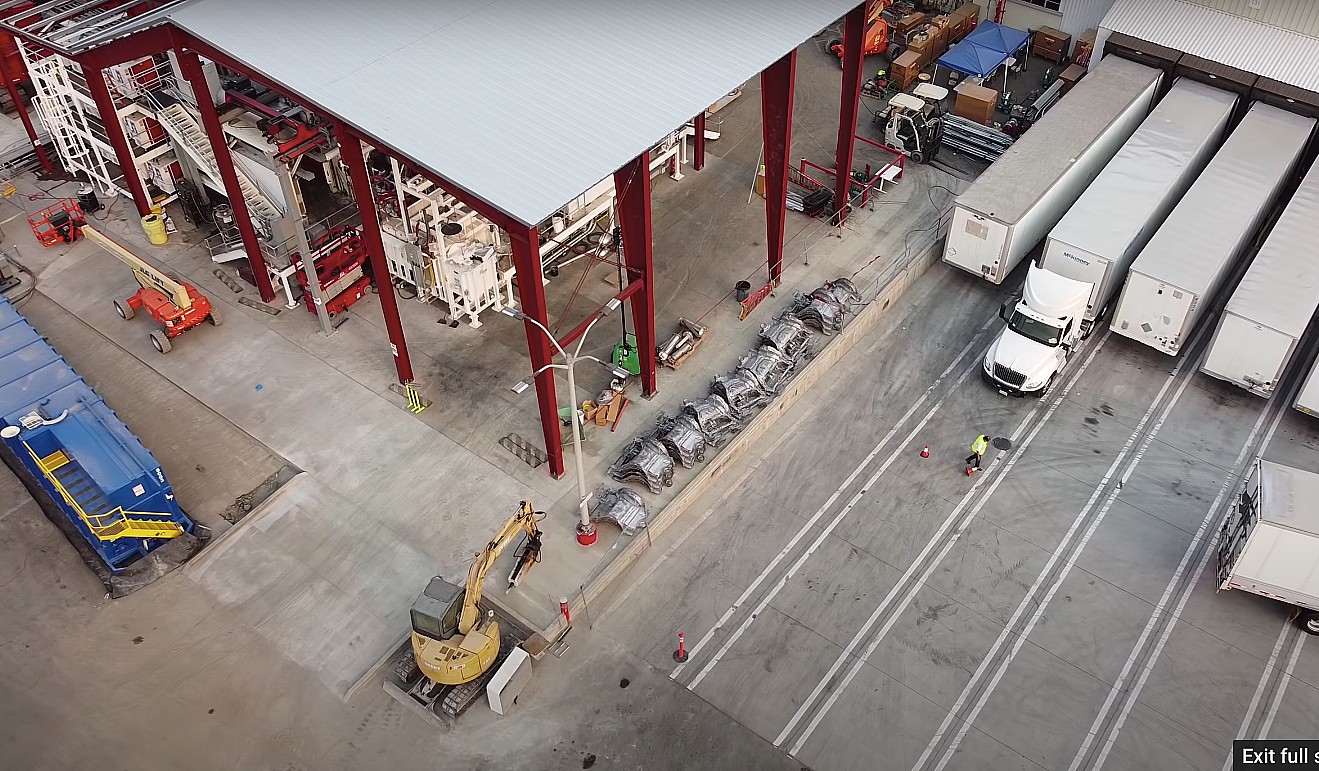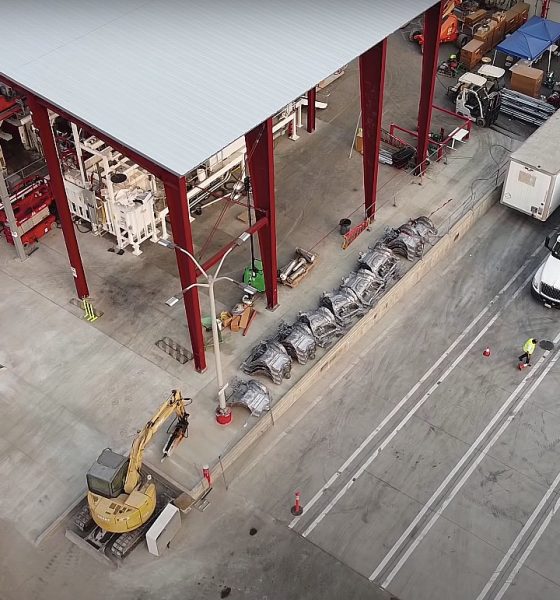During the Tesla Model Y’s teardown by auto veteran Sandy Munro, it was observed that the all-electric crossover only had two massive casts for its rear underbody. This was seen as a significant improvement from the Model 3, whose rear casting was notably over-engineered with about 70 pieces of metal. Yet even with these improvements, Tesla and its CEO, Elon Musk, noted that eventually, the Model Y’s rear underbody will only be comprised of a single piece.
Aerial footage of the Fremont Factory suggests that the electric car maker has begun to test the production of the Model Y’s single-piece rear casts. Tesla enthusiast Gabeincal recently conducted a flyover of Tesla’s Fremont facilities, from the Roadrunner line in Kato Road to the new developments in the main vehicle production plant. Based on the Tesla enthusiast’s drone footage, it seemed evident that the company is currently deploying what appears to be a second “Giga Press” machine on the grounds of the Fremont factory.
The “Giga Press,” which is produced by Italy-based Idra Group, is arguably one of the largest of its kind in the market, with a clamping force of 55,000 to 61,000 kilonewtons. So far, there are two of these machines in the Fremont Factory, and one is already producing vehicle parts. Interestingly enough, the parts that were spotted in the drone flyover seem to be single-piece casts for the Model Y’s rear subframe.
With this in mind, it appears that Tesla is now at a point where it is optimizing the Model Y’s production process. Reports have pointed to Gigafactory Shanghai also receiving a “Giga Press” for its Model Y production line in its Phase 2 zone, and filings from the electric car maker indicate that Giga Berlin will deploy a whopping eight “Giga Presses” for its operations. The utilization of these machines, together with other innovations, should allow Tesla to improve its operating costs, as observed by auto teardown expert Sandy Munro during his analysis of the Model Y.
Elon Musk has previously stated that the idea for using large casts for the Model Y was inspired by the Hot Wheels versions of Tesla’s vehicles. “As Sandy accurately pointed out, the rear of the Model 3 looks like a patchwork quilt. It’s not great… The current version of the Model Y has basically two big high-pressure die-cast aluminum castings that are joined. Later this year, we will transition a single piece casting that also integrates the two rear crash rails,” he said.
The Tesla Model Y is still being ramped in the Fremont Factory, and with the “Giga Presses” coming online, it would only be a matter of time before the production of the all-electric crossover could be optimized and improved. This bodes well for Tesla overall, especially considering that the company faced numerous challenges during the ramp of the Model 3. The ongoing Model Y ramp, as well as the relatively quick deployment of the “Giga Press” machines, shows that Tesla intends to evade the issues that plagued it during the Model 3’s initial production.
Watch the recent footage of Tesla’s “Giga Press” machines at the Fremont factory in the video below.

News
Tesla FSD fleet is nearing 7 billion total miles, including 2.5 billion city miles
As can be seen on Tesla’s official FSD webpage, vehicles equipped with the system have now navigated over 6.99 billion miles.

Tesla’s Full Self-Driving (Supervised) fleet is closing in on almost 7 billion total miles driven, as per data posted by the company on its official FSD webpage.
These figures hint at the massive scale of data fueling Tesla’s rapid FSD improvements, which have been quite notable as of late.
FSD mileage milestones
As can be seen on Tesla’s official FSD webpage, vehicles equipped with the system have now navigated over 6.99 billion miles. Tesla owner and avid FSD tester Whole Mars Catalog also shared a screenshot indicating that from the nearly 7 billion miles traveled by the FSD fleet, more than 2.5 billion miles were driven inside cities.
City miles are particularly valuable for complex urban scenarios like unprotected turns, pedestrian interactions, and traffic lights. This is also the difference-maker for FSD, as only complex solutions, such as Waymo’s self-driving taxis, operate similarly on inner-city streets. And even then, incidents such as the San Francisco blackouts have proven challenging for sensor-rich vehicles like Waymos.
Tesla’s data edge
Tesla has a number of advantages in the autonomous vehicle sector, one of which is the size of its fleet and the number of vehicles training FSD on real-world roads. Tesla’s nearly 7 billion FSD miles then allow the company to roll out updates that make its vehicles behave like they are being driven by experienced drivers, even if they are operating on their own.
So notable are Tesla’s improvements to FSD that NVIDIA Director of Robotics Jim Fan, after experiencing FSD v14, noted that the system is the first AI that passes what he described as a “Physical Turing Test.”
“Despite knowing exactly how robot learning works, I still find it magical watching the steering wheel turn by itself. First it feels surreal, next it becomes routine. Then, like the smartphone, taking it away actively hurts. This is how humanity gets rewired and glued to god-like technologies,” Fan wrote in a post on X.
News
Tesla starts showing how FSD will change lives in Europe
Local officials tested the system on narrow country roads and were impressed by FSD’s smooth, human-like driving, with some calling the service a game-changer for everyday life in areas that are far from urban centers.

Tesla has launched Europe’s first public shuttle service using Full Self-Driving (Supervised) in the rural Eifelkreis Bitburg-Prüm region of Germany, demonstrating how the technology can restore independence and mobility for people who struggle with limited transport options.
Local officials tested the system on narrow country roads and were impressed by FSD’s smooth, human-like driving, with some calling the service a game-changer for everyday life in areas that are far from urban centers.
Officials see real impact on rural residents
Arzfeld Mayor Johannes Kuhl and District Administrator Andreas Kruppert personally tested the Tesla shuttle service. This allowed them to see just how well FSD navigated winding lanes and rural roads confidently. Kruppert said, “Autonomous driving sounds like science fiction to many, but we simply see here that it works totally well in rural regions too.” Kuhl, for his part, also noted that FSD “feels like a very experienced driver.”
The pilot complements the area’s “Citizen Bus” program, which provides on-demand rides for elderly residents who can no longer drive themselves. Tesla Europe shared a video of a demonstration of the service, highlighting how FSD gives people their freedom back, even in places where public transport is not as prevalent.
What the Ministry for Economic Affairs and Transport says
Rhineland-Palatinate’s Minister Daniela Schmitt supported the project, praising the collaboration that made this “first of its kind in Europe” possible. As per the ministry, the rural rollout for the service shows FSD’s potential beyond major cities, and it delivers tangible benefits like grocery runs, doctor visits, and social connections for isolated residents.
“Reliable and flexible mobility is especially vital in rural areas. With the launch of a shuttle service using self-driving vehicles (FSD supervised) by Tesla in the Eifelkreis Bitburg-Prüm, an innovative pilot project is now getting underway that complements local community bus services. It is the first project of its kind in Europe.
“The result is a real gain for rural mobility: greater accessibility, more flexibility and tangible benefits for everyday life. A strong signal for innovation, cooperation and future-oriented mobility beyond urban centers,” the ministry wrote in a LinkedIn post.
News
Tesla China quietly posts Robotaxi-related job listing
Tesla China is currently seeking a Low Voltage Electrical Engineer to work on circuit board design for the company’s autonomous vehicles.

Tesla has posted a new job listing in Shanghai explicitly tied to its Robotaxi program, fueling speculation that the company is preparing to launch its dedicated autonomous ride-hailing service in China.
As noted in the listing, Tesla China is currently seeking a Low Voltage Electrical Engineer to work on circuit board design for the company’s autonomous vehicles.
Robotaxi-specific role
The listing, which was shared on social media platform X by industry watcher @tslaming, suggested that Tesla China is looking to fill the role urgently. The job listing itself specifically mentions that the person hired for the role will be working on the Low Voltage Hardware team, which would design the circuit boards that would serve as the nervous system of the Robotaxi.
Key tasks for the role, as indicated in the job listing, include collaboration with PCB layout, firmware, mechanical, program management, and validation teams, among other responsibilities. The role is based in Shanghai.
China Robotaxi launch
China represents a massive potential market for robotaxis, with its dense urban centers and supportive policies in select cities. Tesla has limited permission to roll out FSD in the country, though despite this, its vehicles have been hailed as among the best in the market when it comes to autonomous features. So far, at least, it appears that China supports Tesla’s FSD and Robotaxi rollout.
This was hinted at in November, when Tesla brought the Cybercab to the 8th China International Import Expo (CIIE) in Shanghai, marking the first time that the autonomous two-seater was brought to the Asia-Pacific region. The vehicle, despite not having a release date in China, received a significant amount of interest among the event’s attendees.










